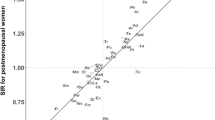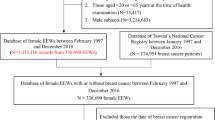Abstract
Purpose
Relatively little work has been done concerning occupational risk factors in ovarian cancer. Although studies conducted in occupational settings have reported positive associations, their usefulness is generally limited by the lack of information on important confounders. In a population-based case–control study, we assessed risk for developing epithelial ovarian cancer (EOC) associated with occupational exposure while accounting for important confounders.
Methods
Participants were identified through provincial population-based registries. Lifetime occupational history and information on potential confounding factors were obtained through a self-administered questionnaire. Unconditional logistic regression and the likelihood ratio test were used to assess EOC risk with each occupation (or industry), relative to all other occupations (or industries), adjusting for potential confounders including body mass index, oral contraceptive use, menopausal hormone therapy, parity, age at first childbirth, age at menarche, age at menopause, family history of breast and ovarian cancer in mother and sister(s), tubal ligation, partial oophorectomy, and hysterectomy. Occupations and industries were coded according to the Canadian Standard Occupational Classification (SOC) and Standard Industrial Classification (SIC).
Results
Significant excess risk was observed for several groups of teaching occupations, including SOC 27, teaching and related (adjusted OR 1.77, 95 % CI 1.15–2.81) and SOC 279, other teaching and related (adjusted OR 3.11, 95 % CI 1.35–8.49). Significant excess was also seen for a four-digit occupational group SOC 4131, bookkeepers and accounting clerks (adjusted OR 2.80, 95 % CI 1.30–6.80). Industrial sub-groups showing significant excess risk included SIC 65, other retail stores (adjusted OR 2.19, 95 % CI 1.16–4.38); SIC 85, educational service (adjusted OR 1.45, 95 % CI 1.00–2.13); and SIC 863, non-institutional health services (adjusted OR 2.54, 95 % CI 1.13–6.52).
Conclusions
Our study found an elevated EOC risk for teaching occupations and is the first study to observe such an increased risk after adjustment for potential confounders. Further studies with more detailed assessment of the work environment and unique lifestyle characteristics may be fruitful in elucidating this etiology.
Similar content being viewed by others
References
Sankaranarayanan R, Ferlay J (2006) Worldwide burden of gynaecological cancer: the size of the problem. Best Pract Res Clin Obstet Gynaecol 20:207–225
Ferlay J, Bray F, Pisani P, Parkin DM (2004) GLOBOCAN 2002: cancer incidence, mortality, and prevalence worldwide IARC Cancer Base No. 5. version 2.0, IARC Press, Lyon, France. http://www-dep.iarc.fr/
Canadian Cancer Statistics (2012) National Cancer Institute of Canada 2012
American Cancer Society (2012) Cancer facts and figures 2012. American Cancer Society, Atlanta
Permuth-Wey J, Sellers TA (2009) Epidemiology of ovarian cancer. Methods Mol Biol Cancer Epidemiol 472:413–433
La Vecchia C (2001) Epidemiology of ovarian cancer: a summary review. Eur J Cancer Prev 10:125–129
Adami HO, Hsieh CC, Lambe M, Trichopoulos D, Leon D, Persson I, Ekbom A, Janson PO (1994) Parity, age at first childbirth, and risk of ovarian cancer. Lancet 344:1250–1254
Whittemore AS, Harris R, Itnyre J, The Collaborative Ovarian Cancer Group (1992) Characteristics relating to ovarian cancer risk: collaborative analysis of 12 case–control studies. II. Invasive, epithelial ovarian cancers in white women. Am J Epidemiol 136:1204–1211
Rosenberg L, Palmer JR, Zauber AG, Warshauer ME, Lewis JL, Strom BL, Harlap S, Shapiro S (1994) A case–control study of oral contraceptive use and invasive epithelial ovarian cancer. Am J Epidemiol 139:654–661
Vessey M, Painter R (2006) Oral contraceptive use and cancer. Findings in a large cohort study, 1968–2004. Br J Cancer 95:385–389
Rosenblatt KA, Thomas DB, Noonan EA (1992) High-dose and lowdose combined oral contraceptives: protection against epithelial ovarian cancer and the length of the protective effect. The WHO collaborative study of neoplasia and steroid contraceptives. Eur J Cancer 28A:1872–1876
Parazzini F, Negri E, LaVecchia C et al (1993) Hysterectomy, oophorectomy, and subsequent ovarian cancer risk. Obstet Gynecol 81:363–366
Chiaffarino F, Parazzini F, Decarli A, Franceschi S, Talamini R, Montella M, La Vecchia C (2005) Hysterectomy with or without unilateral oophorectomy and risk of ovarian cancer. Gynecol Oncol 97:318–322
Negri E, Pelucchi C, Franceschi S, Montella M, Conti E, Dal Maso L, Parazzini F, Tavani A, Carbone A, La Vecchia C (2003) Family history of cancer and risk of ovarian cancer. Eur J Cancer 39:505–510
Frank TS, Manley SA, Olopade OI, Cummings S, Garber JE et al (1998) Sequence analysis of BRCA1 and BRCA2: correlation of mutations with family history and ovarian cancer risk. J Clin Oncol 16:2417–2425
Schottenfeld D, Faumeni JF (2006) Cancer epidemiology and prevention, 3rd edn. Oxford University Press, Oxford
Lie JA, Andersen A, Kjaerheim K (2007) Cancer risk among 43000 Norwegian nurses. Scand J Work Environ Health 33:66–73
King AS, Threlfall WJ, Band PR, Gallagher RP (1994) Mortality among female registered nurses and school teachers in British Columbia. Am J Ind Med 26:125–132
Sala M, Dosemeci M, Zahm SH (1998) A death certificate-based study of occupation and mortality from reproductive cancers among women in 24 US states. J Occup Environ Med 40:632–639
Petralia SA, Dosemeci M, Adams EE, Zahm SH (1999) Cancer mortality among women employed in health care occupations in 24 U.S. states, 1984–1993. Am J Ind Med 36:159–165
MacArthur AC, Le ND, Abanto ZU, Gallagher RP (2007) Occupational female breast and reproductive cancer mortality in British Columbia, Canada, 1950–94. Occup Med 57(4):246–253
Katz RM (1983) Causes of death among registered nurses. J Occup Med 25:760–762
Shen N, Weiderpass E, Anttila A, Goldberg MS, Vasama-Neuvonen KM, Boffetta P, Vainio HU, Partanen TJ (1998) Epidemiology of occupational and environmental risk factors related to ovarian cancer. Scand J Work Environ Health 24:175–182
Spinelli JJ, Gallagher RP, Threlfall WJ (1984) Multiple myeloma, leukaemia and cancer of the ovary in cosmetologists and hairdressers. Am J Ind Med 6:907–1002
Teta MJ, Walrath J, Meigs JW, Flannery JT (1984) Cancer incidence among cosmetologists. J Natl Cancer Inst 5:1051–1057
Boffeta P, Andersen A, Lynge E et al (1994) Employment as hairdresser and risk of ovarian cancer and non-hodgkin’s lymphomas among women. J Occup Environ Med 36:61–65
Vasama-Neuvonen K, Pukkala E, Paakkulainen H, Mutanen P, Weiderpass E, Boffetta P, Shen N, Kauppinen T, Vainio H, Partanen T (1999) Ovarian cancer and occupational exposures in Finland. Am J Ind Med 36:83–89
Lamba AB, Ward MH, Weeks JL, Dosemeci M (2001) Cancer mortality among hairdressers and barbers in 24 US States, 1984 to 1995. J Occup Environ Med 43:250–258
Kauppinen T, Toikkanen J, Pukkala E (1998) From cross-tabulations to multipurpose exposure information system: a new job-exposure matrix. Am J Ind Med 33:409–417
Tzonou A, Polychronopoulou A, Hsieh C et al (1993) Hair dyes, analgesics, tranquilizers and perineal talc application as risk factors for ovarian cancer. Int J Cancer 55(408):410
Constanza Camargo M, Stayner LT, Straif K, Reina M, Al-Alem U, Demers PA, Landrigan PJ (2011) Occupational exposure to asbestos and ovarian cancer: a meta-analysis. Environ Health Perspect 119(9):1211–1217
Reid A, de Klerk N, Musk AW (2011) Does exposure to asbestos cause ovarian cancer? A systematic literature review and meta-analysis. Cancer Epidemiol Biomarkers Prev 20(7):1287–1295
Tokuoka S, Kawai K, Shimizu Y et al (1987) Malignant and benign ovarian neoplasms among atomic bomb survivors, Hiroshima and Nagasaki, 1950–80. J Natl Cancer Inst 79:47–57
Wagoner JK (1984) Leukemia and other malignancies following radiation therapy for gynecological disorders. In: Boice JD Jr, Fraumeni JF Jr (eds) Radiation carcinogenesis: epidemiology and biological significance. Raven Press, New York
Doll R, Smith PG (1968) The long-term effects of X irradiation in patients treated for metropathia haemorrhagica. Br J Radiol 41:362–368
Dosemeci M, Blair A (1994) Occupational cancer mortality among women employed in the telephone industry. J Occup Environ Med 36:1204–1209
Morgan RW, Kelsh MA, Zhao K, Heringer S (1998) Mortality of aerospace workers exposed to trichloroethylene. Epidemiology 9:424–431
Wernli KJ, Ray RM, Gao DL, Fitzgibbons ED, Camp JE, Astrakianakis G, Seixas N, Li W, De Roos AJ, Feng Z, Thomas DB, Checkoway H (2008) Occupational risk factors for endometrial cancer among textile workers in Shanghai, China. Am J Ind Med 51(9):673–679
Bulbulyan MA, Ilychova SA, Zahm SH, Astashevsky SV, Zaridze DG (1999) Cancer mortality among women in the russian printing industry. Am J Ind Med 36:166–171
Langseth H, Andersen A (1999) Cancer incidence among women in the Norwegian pulp and paper industry. Am J Ind Med 36:108–113
Band PR, Spinelli JJ, Threlfall WJ, Fang R, Le DN, Gallagher RP (1999) Identification of occupational cancer risks in British Columbia. Part l: methodology, descriptive results, and analysis of cancer risks, by cigarette smoking categories of 15463 incident cancer cases. J Occup Environ Med 41:224–232
Standard Occupational Classification 1980 (1981) Ottawa: Minister of Supplies and Services Canada (Statistics Canada Catalogue No 12-565E)
Standard Industrial Classification 1980 (1981) Ottawa: Minister of Supplies and Services Canada (Statistics Canada Catalogue No 12-501E)
Rothman KJ, Greenland S, Lask TL (2008) Modern epidemiology, 3rd edn. Lippincott Williams & Wilkins, Philadephia
Venables WN, Smith DM (2009) Introduction to R, 2nd Edition. Network Theory Limited
Pukkala E (1995) Cancer risk by social class and occupation. A survey of 109,000 cancer cases among Finns of working age. Contrib Epidemiol Biostat Karger 7:63–76
Drewer F (1995) Occupational decennial supplement. Government Statistical Services. HMSO, London
California Teachers Study https://www.calteachersstudy.org/WebsiteGraphs.html#IDX4
Bhatti P, Cushing-Haugen KL, Wicklund KG, Doherty JA, Rossing MA (2013) Nightshift work and risk of ovarian cancer. Occup Environ Med 70:231–237
Pool EM, Schernhammer ES, Tworoger SS (2011) Rotating night shift work and risk of ovarian cancer. Cancer Epidemiol Biomarkers Prev 20(5):934–938
Shields T, Gridley G, Moradi T, Adami J, Plato N, Desemeci M (2002) Occupational exposures and the risk of ovarian cancer in Sweden. Am J Ind Med 42:200–213
Zhang M, Xie X, Lee AH, Binns CW (2004) Sedentary behaviours and epithelial ovarian cancer risk. Cancer Causes Control 15(1):83–89
Patel AV, Rodriguez C, Pavluck AL, Thun MJ, Calle EE (2006) Recreational physical activity and sedentary behaviour in relation to ovarian caner risk in a large cohort of US women. Am J Epidemiol 163:709–716
Galea S, Tracy M (2007) Participation rates in epidemiologic studies. Ann Epidemiol 17:643–653
Acknowledgments
The authors thank two anonymous reviewers for their valuable comments and suggestions which led to an improved presentation of the paper. This research was partially supported by grants from WorkSafe BC (formerly the Workers’ Compensation Board of British Columbia). We gratefully acknowledge the invaluable contribution of the research coordinators and assistants: Barbara Jamieson, Donna Kan, Zenaida Abanto, and Lynn Vo.
Conflict of interest
The authors declare that they have no conflict of interest.
Author information
Authors and Affiliations
Corresponding author
Rights and permissions
About this article
Cite this article
Le, N.D., Leung, A., Brooks-Wilson, A. et al. Occupational exposure and ovarian cancer risk. Cancer Causes Control 25, 829–841 (2014). https://doi.org/10.1007/s10552-014-0384-4
Received:
Accepted:
Published:
Issue Date:
DOI: https://doi.org/10.1007/s10552-014-0384-4




